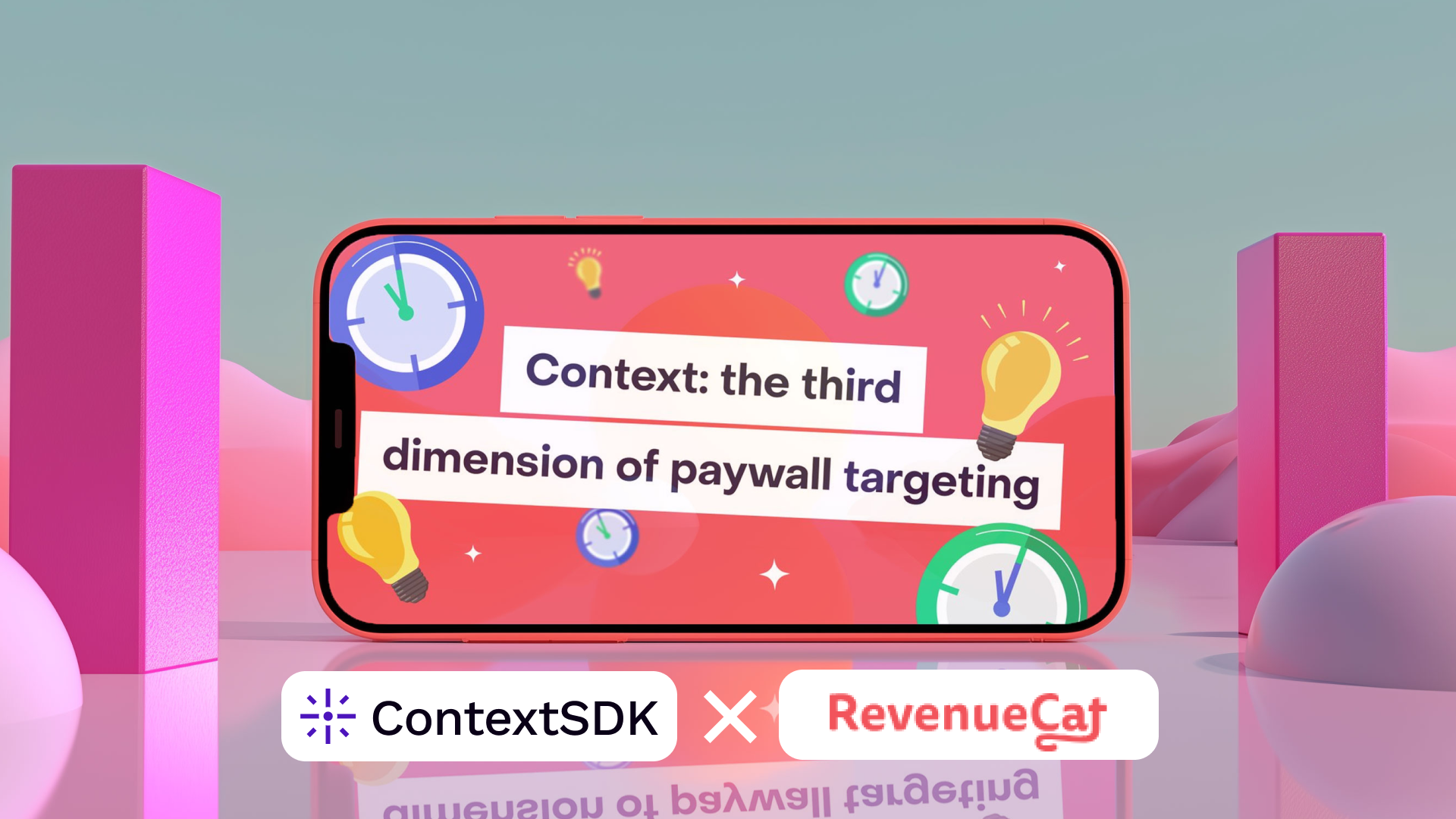Beyond Monetization: What Great Paywalls Actually Do


Introduction
The term "paywall" has always felt limiting. It suggests a cold barrier - pay up or get out. But as RevenueCat’s Daphne Tideman highlights, modern paywalls can do much more than sell. They educate, build trust, create emotional connections, and guide behavior. The challenge? Even the most brilliantly designed paywall will fail if it appears at the wrong moment.
This is where context becomes everything. A paywall shown when users are distracted, frustrated, or simply not in the right mental state to make decisions will underperform no matter how well-crafted it is. Understanding when to show your paywall is just as critical as what it says.
7 Unexpected Uses for Your Paywall
Effective paywalls can:
- Educate and frame value
- Build trust
- Create an emotional connection
- Guide user behavior
- Reinforce progress
- Improve retention
- Gather customer insights
But here's the catch: all of these benefits depend on showing your paywall when users are actually receptive to it. Let's explore each use case and how context-aware timing amplifies results.
1. Educate and Frame Value (When Users Are Ready to Learn)
If you want people to pay, you must clearly convey value. Golf Gamebook does this brilliantly by highlighting exactly what users can do - live leaderboards, tournament creation, and lowering their handicap 4x faster.
The context factor: Educational paywalls work best when users are in a calm, focused state - not when they're rushing through your app or multitasking. By using signals like battery level, time of day, and motion state, you can identify moments when users have the mental bandwidth to absorb information. A paywall shown during a commute or while walking will perform worse than one shown when users are stationary and relaxed.
Vivid, a banking app, presents feature comparisons across plans with swipeable cards. This works because they recognize that financial decisions require focus. Showing this paywall when users are low on battery or in motion would be counterproductive - they simply won't engage with detailed comparisons in those states.
Research from Hanna Grevelius at Bruce Studios shows that simple, clear paywalls consistently outperform polished designs. But even the simplest paywall fails when shown at a moment of high cognitive load. Context-aware timing ensures your educational content lands when users can actually process it.
2. Build Trust (At Moments of Low Anxiety)
Trust isn't automatic just because someone downloaded your app. It's earned over time - and your paywall is a critical trust-building moment.
Bloom (acquired by Spring Health) mastered this with a two-part paywall that emphasized honesty: clear trial terms, full refund promises, and social proof (loved by 2M users, 4.8/5 rating, App of the Day). This transparency builds confidence.
The context factor: Trust-building works best when users aren't stressed or anxious. Showing a paywall during a high-stress moment - when battery is critically low, or users are rushing somewhere - creates friction. ContextSDK can detect these anxiety-inducing states through motion patterns, battery level, and other signals. By avoiding these moments, you ensure users can properly evaluate your trust signals rather than dismissing them reflexively.
Rocket Money takes an unusual approach by letting users set their own price. This radical transparency builds trust, but only works if users are in a mental state to appreciate the gesture. Show this during a calm moment, and it feels empowering. Show it when they're stressed, and it feels like extra work.
The key: ethical monetization (clear pricing, transparent trials, straightforward cancellation) builds trust. But that trust only lands when users have the mental space to recognize it.
3. Create an Emotional Connection (When Users Are Emotionally Available)
According to research on customer emotions, there are ten emotional drivers behind behavior: standing out from the crowd, confidence in the future, sense of well-being, freedom, thrill, belonging, environmental protection, being your best self, security, and success.
Ladder, a workout app, taps into the success driver with "Get results, without planning workouts." Simple. Clear. Emotionally resonant.
The context factor: Emotional messaging requires emotional availability. Users who are rushing, stressed, or cognitively overloaded won't connect with your emotional appeals - they're in survival mode, not aspiration mode. By detecting calm states through signals like stationary position, good battery level, and low screen time pressure, you can show emotional paywalls when users are actually receptive to feeling something.
KOHO, a Canadian financial app, shifts from educational paywalls during onboarding to emotionally-driven paywalls later, visualizing outcomes like buying a house or getting a better car loan. This taps into the security driver. But showing this when users are in a taxi, low on battery, and running late would kill the emotional impact. Context ensures these moments land when users can actually envision their future.
CoinStats experiments with quirky, personality-driven paywalls (like Giga Chad dressed as Santa for crypto traders). This playfulness builds connection - but only if users are in the mood to engage with humor. Real-world context detection ensures you're not trying to be funny at the wrong moment.
4. Guide User Behavior (When Decision-Making Capacity Is High)
Most users don't know which plan is right for them. Your paywall should reduce this friction by guiding them toward the best choice.
Duolingo and Fitplan do this well with clear pricing breakdowns, highlighted popular options, and "Best Value" badges. These decision aids work - when users have the cognitive capacity to evaluate options.
The context factor: Decision-making is mentally taxing. Research shows decision quality degrades under cognitive load. If users are multitasking, in motion, or experiencing low battery anxiety, they'll default to the easiest choice (often "close" or "not now"). ContextSDK helps you identify high-capacity moments - when users are stationary, calm, and have time - to present decision-heavy paywalls.
Linktree serves multiple audiences (creators and businesses) with different plan needs. Their paywall clearly explains each option with expandable details. But this only works if users have the patience to explore. Showing this during a moment of high motion or time pressure would backfire.
Vahe Baghdasaryan from Flo Health found that simplifying paywalls improved conversion in three out of four tests. But simplicity alone isn't enough - you also need the right moment. A simple paywall at the wrong time still fails.
5. Reinforce Progress (When Users Are Primed for Motivation)
For fitness, education, and productivity apps, showing progress on your paywall can be powerful motivation.
Bloom acknowledges completing registration as progress. Opal, a focus app, shows a timeline: "You got your focus diagnosis today. By day six, you'll see results." This frames the trial as a no-lose situation.
The context factor: Motivational messaging works best when users are in a positive, forward-looking mental state. After completing a workout, finishing a task, or achieving a milestone, users are primed to feel good about progress. ContextSDK can help you identify these high-motivation windows through usage patterns and session context. Showing a progress-focused paywall after a user just gave up on something or is rushing through the app won't land the same way.
AllTrails states: "AllTrails+ members are 3 times more likely to hit the trail." This combines progress with aspiration. But if you show this when users are stationary at home in the evening, it resonates. Show it when they're already on a trail with spotty connectivity, and it's just annoying.
Cleo, a banking app, makes subscription selection one of the last to-dos, creating a sense of completion. This works because users are in "finish mode" - but only if they're actually engaged with completing tasks. Real-world context helps you avoid showing this when users are distracted or dropping off.
6. Improve Retention (By Prioritizing Quality Over Quick Conversions)
Paywalls influence retention by guiding plan choices, but the real retention boost comes from emotional connection, progress reinforcement, and customer value prioritization.
5 Minute Journal highlights annual value by offering trials only on yearly plans. While this may increase ARPPU, it doesn't necessarily improve real retention if users aren't engaged.
The context factor: Quality conversions happen when users genuinely understand and value what they're buying. This requires the right mental state. Rushed conversions at high-stress moments may boost short-term metrics but hurt long-term retention. By using context signals to identify calm, engaged moments, you can prioritize conversions that stick. Users who subscribe when they're actually considering it, rather than just trying to dismiss an interruption, are more likely to remain active subscribers.
Headspace emphasizes that meditation takes time, encouraging annual subscriptions by aligning with long-term practice. This message works when users are in a reflective state - perhaps after a meditation session - not when they're frantically multitasking.
The key insight: better retention comes from showing paywalls when users can make thoughtful decisions, not impulsive ones.
7. Gather Customer Insights (From Meaningful Interactions)
Paywalls offer opportunities to test messaging, designs, and even gather direct feedback through post-dismissal surveys.
The context factor: The quality of insights depends on the quality of interactions. If users dismiss your paywall because it appeared at a bad time (low battery, high motion, time pressure), their feedback isn't about your paywall - it's about the interruption. ContextSDK helps you separate signal from noise by ensuring paywalls appear when users can properly evaluate them. Survey responses from users who engaged with your paywall in a calm state are far more valuable than dismissals from stressed users.
Testing messaging angles on paywalls is powerful, but only if you control for context. A headline that performs poorly might actually be great - it just appeared at the wrong moments. Conversely, a mediocre message might look good because it happened to be shown at optimal times.
Should Your Paywall Do All of This?
No. The key is intentional prioritization based on your app, audience, and placement. But across all these goals, one factor remains constant: timing matters.
Vahe recently shared a case study where a food app increased install-to-trial conversion by 72% by simplifying their paywall and highlighting a key stat: "86% of users improved their diet." This worked because they reduced cognitive load while building trust.
But imagine if that same paywall appeared when users were walking, low on battery, and hadn't opened the app in days. The conversion rate would plummet - not because the paywall was bad, but because the context was wrong.
The ContextSDK Advantage: Making Every Paywall Strategy Work Better
ContextSDK provides real-world context signals - battery level, motion state, time of day, and over 300+ other signals - to help you identify when users are actually receptive to your paywall, regardless of which strategy you're pursuing:
- For educational paywalls: Show them when users have mental bandwidth to process information
- For trust-building: Avoid high-stress moments when users can't properly evaluate transparency
- For emotional connection: Target moments when users are emotionally available
- For decision guidance: Present choices when cognitive capacity is high
- For progress reinforcement: Capitalize on high-motivation windows
- For retention: Prioritize quality conversions over rushed ones
- For gathering insights: Ensure feedback comes from meaningful interactions
Your paywall can do far more than sell - but only if it appears at the right moment. Context-aware timing doesn't just improve conversion rates; it enhances every benefit your paywall offers, from education to emotional connection to long-term retention.
The best paywall at the wrong time is still a bad experience. The right paywall at the right moment? That's when magic happens.






